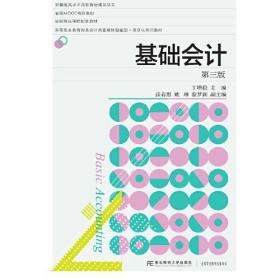
基础会计
全新正版 极速发货
¥ 37.39 6.4折 ¥ 58 全新
库存4件
广东广州
认证卖家担保交易快速发货售后保障
作者杨顺华
出版社江苏大学出版社
ISBN9787568409100
出版时间2018-08
装帧平装
开本16开
定价58元
货号1201751653
上书时间2024-08-05
- 最新上架
商品详情
- 品相描述:全新
- 商品描述
-
目录
Chapter 1 Introduction to the Finan Statements
Learning Objectives
Chapter Opening
1.1 Types of Business Organization
1.2 Several Key Accounting Principles
1.2.1 Measurement Rules
1.2.2 Reporting Entities
1.2.3 Historical Cost Principle
1.2.4 Reliability Principle
1.2.5 Conservatism Principle
1.2.6 Materiality Principle
1.2.7 Going Concern Assumption and Periodicity Assumption
1.2.8 Matching Principle
1.3 Elements of Finan Statements
1.3.1 Using Accounts to Gather Information
1.3.2 Assets, Income, and Claims on Assets
1.4 The Accounting Equation
1.5 The Horizontal Finan Statements Model
1.5.1 Transaction Analysis Using Finan Statements Effects Tables (FSET)
1.5.2 Types of Transactions
1.5.3 Summary of Transactions
1.6 Preparing Finan Statements
1.6.1 Income Statement
1.6.2 Statement of Changes in Stockholders Equity
1.6.3 Balance Sheet
1.6.4 Statement of Cash Flows
1.6.5 How the Four Finan Statements Interrelate
1.6.6 The Closing Process
1.7 Summary
Self-Study Review Problem
Solutions to Self-Study Problems
Exercises
Chapter 2 Accounting for Accrual Events
Learning Objectives
Chapter Opening
2.1 Accrual Accounting
2.1.1 Accounting for Accounts Receivable
2.1.2 Accounting for Accrued Salary Expense
2.1.3 Other Events
2.1.4 Summary of Events
2.2 The General Ledger
2.3 Vertical Statements Model
2.4 The Closing Process
2.5 Steps in an Accounting Cycle
2.6 The Matching Concept
2.7 Summary
Self-Study Review Problem
Solutions to Self-Study Problems
Exercises
Chapter 3 Accounting for Deferral Events
Learning ObjectJves
Chapter Opening
3.1 Deferral Accounting
3.1.1 Accounting for Receipt of Unearned Revenue
3.1.2 Accounting for Supplies Purchase
3.1.3 Prepaid Items
3.2 Adjusting Entries
3.2.1 Accounting for Depreciation Expense
3.2.2 Accounting for Supplies
3.2.3 Accounting for Prepaid Rent
3.2.4 Accounting for Unearned Revenue
3.3 The General Ledger
3.4 Vertical Statements Model
3.5 Summary
Self-Study Review Problem
Solutions to Self-Study Problems
Exercises
Chapter 4 Understanding the Debit-Credit System
Learning Objectives
Chapter Opening
4.1 Rules for Double-Entry Transactions
4.2 The General Journal
4.3 The General Ledger
4.4 Trial Balance
4.5 Understand the Process of "Closing the Books" at the End of the
Fiscal Year
4.6 Understand all Steps in the Bookkeeping Cycle
4.7 Illustration of Recording Procedures
4.7.1 Finan Statements Effects Tables (FSET) with Journal
Entries(J/Es)
4.7.2 The General Ledger after Posting Is Shown below
4.7.3 Preparing A Pre-Closing Trial Balance
4.7.4 Preparing the Finan Statements and Closing the Books
4.8 Summary
Self-Study Review Problem
Solutions to Self-Study Problems
Exercises
Chapter 5 Accounting for Merchandising Events
Learning Objectives
Chapter Opening
5.1 Product Costs versus Selling and Administrative Costs
5.2 Allocating Inventory Cost between Asset and Expense Accounts
5.3 Perpetual Inventory System
5.3.1 Terms Used to Describe Transportation Costs, Cash Discounts,
and Returns or Allowances
5.3.2 Year-end Adjustment Required for Lost, Damaged, or Stolen Inventory
5.4 Periodic Inventory System
5.5 Advantages and Disadvantages of the Periodic System versus
the Perpetual System
5.6 Multi-step Income Statement
5.7 Transaction Analysis Using Finan Statements Effects Tables (FSETs) and
5.8 Understand the Gross Margin Ratio and the Return on Sales Ratio
5.9 Summary
Self-Study Review Problem
Solutions to Self-Study Problems
Exercises
6 Accounting for Inventories
Learning Objectives
Chapter Opening
6.1 Inventory Cost Flow Methods
6.1.1 Specific Identification
6.1.2 First-In, First-Out (FIFO)
6.1.3 Last-In, First-Out (LIFO)
6.1.4 Weighted Average
6.1.5 Physical Flow
6.2 Effect of Cost Flow on Finan Statements
6.2.1 Effect on Income Statement
6.2.2 Effect on Balance Sheet
6.3 Inventory Cost Flow under a Perpetual Inventory System
6.3.1 Multiple Layers with Multiple Quantities
6.3.2 Allocating Cost of Goods Available for Sale
6.3.3 Effect of Cost Flow on Finan Statements
6.3.4 The Impact of Income Tax
6.4 Inflationary and Deflationary
6.5 Disclosure and Consistency
6.6 Lower-of-Cost-or-Market Rule
6.7 The Gross Margin Method of Estimating Ending Inventory
6.8 The Importance and Computation of Average Days to Sell Inventory
6.9 Cost of Financing Inventory
6.10 Summary
Self-Study Review Problem
Solutions to Self-Study Problems
Exercises
Chapter 7 Short-Term Receivables and Payables
Learning Objectives
Chapter Opening
7.1 Allowance Method of Accounting for Uncollectible Accounts
7.1.1 Accounting Events Affecting the 2018
7.1.2 Accounting Events Affecting the 2019
7.2 Accounting for Notes Receivable (Promissory Notes)
7.2.1 How Accounting for Notes Receivable Affects Finan Statements
7.2.2 Finan Statements
7.3 Accounting for Credit Card Sales
7.4 Accounting for Current Liabilities
7.4.1 Accounting for Notes Payable
7.4.2 Accounting for Sales Tax
7.4.3 Contingent Liabilities
7.4.4 Warranty Obligations
7.5 Average Days to Collect Accounts Receivables
7.6 The Costs of Financing Credit Sales
7.7 Calculate the Length of an Operating Cycle
7.8 Classified Balance Sheet and Current Ratio
7.9 Summary
Self-Study Review Problem
Solutions to Self-Study Problems
Exercises
8 Accounting for Long-Term Assets
Learning Objectives
Chapter Opening
8.1 Tangible versus Intangible Assets
8.1.1 Tangible Long-Term Assets
8.1.2 Intangible Assets
8.2 Determining the Cost of Long-Term Assets and Basket Purchase Allocation
8.2.1 Determining the Cost of Long Term Assets
8.2.2 Basket Purchase Allocation
8.3 Methods of Recognizing Depreciation Expense
8.4 Revision of Estimates
8.4.1 Revision of Life
8.4.2 Revision of Salvage
8.5 Continuing Expenditures for Plant Assets
8.5.1 Costs That Are Expensed
8.5.2 Costs That Are Capitalized
8.6 Natural Resources
8.7 Accounting for Purchase and Sale of Land
8.8 Intangible Assets
8.8.1 Trademarks
8.8.2 Patents
8.8.3 Copyrights
8.8.4 Franchises
8.8.5 Goodwill
8.9 Expense Recognition for Intangible Assets
8.9.1 Expensing Intangible Assets with Identifiable Useful Lives
8.9.2 Impairment Losses for Intangible Assets with Indefinite Useful Lives
8.10 Summary
Self-Study Review Problem
Solutions to Self-Study Problems
Exercises
Chapter9 Bank Rconcilialion Statement
Learning Objectives
Chapter Opening
9.1 Procedure for Bank Reconciliation
9.1.1 Determining True Cash Balance
9.1.2 Adjustments to the Bank Balance
9.1.3 Adjustments to the Book Balance
9.1.4 Correction of Errors
9.2 Illustrating a Bank Reconciliation
9.2.1 Adjustments to the Bank Balance
9.2.2 Adjustments to the Book Balance
9.3 Updating TSYIs Accounting Records
9.4 Summary
Self-Study Review Problem
Solutions to Self-Study Problems
Exercises
内容摘要
本书从会计恒等式思想出发,使用横向财务报表模式一根主线贯穿全书。旨在帮助学生系统掌握基础会计基本思想及原理,了解基本经济业务的核算,熟悉现金管理方法;掌握企业会计业务处理的基本程序和技术方法,理解存货成本计量方法及其对财务报表的影响,开拓学生的靠前化视野,提高会计理论和实践知识的能力。为其后续的专业课程中级财务会计的学习打好基础。
相关推荐
— 没有更多了 —






















以下为对购买帮助不大的评价